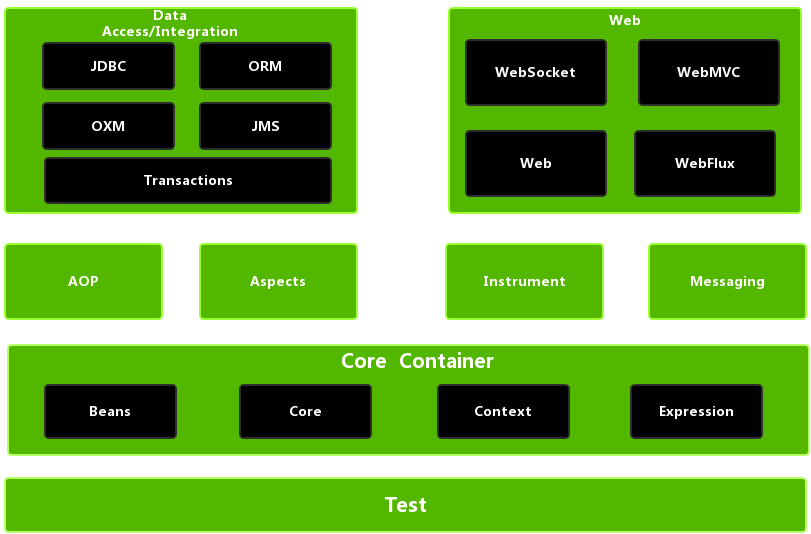- Spring是以Ioc和Aop为内核,提供了表现层spring MVC 和持久层Spring JDBC等众多应用技术,还能整合开源世界众多著名的第三方框架和类库,成为使用最多的JavaEE企业应用开源框架。
- Spring的优势:
- 方便解耦,简化开发;
- Aop编程的支持;
- 声明式事务的支持;
- 方便程序的测试;
- 方便集成各种优秀框架;
- 降低JavaEE API的使用难度;
- Spring源码是经典学习的范例;
- Spring的体系结构:全部基于核心容器Core Container

- 编译时期依赖:JDBC在没有导依赖包时即mysql驱动时,将无法编译。即注册驱动时找不到com.mysql.jdbc.Driver()依赖包;
- 耦合:程序间的依赖关系,其中包括:①类之间的依赖;②方法之间的依赖;
- 解耦:降低程序间的依赖关系,实际开发中应该做到,编译时期不依赖,运行时才依赖;
- 解耦的思路:
- 使用反射来创建对象,而避免使用new关键字,即Class.forName(“全限定类名”)。
- 通过读取配置文件来获取要创建对象的全类名,而不是直接写死,然后再通过反射来创建对象。
- 解耦的方式:
方式一:使用工程模式解耦:(创建Bean对象的工厂,用来创建Service和dao对象的)
1.定义一个配置文件bean.properties配置service和dao层的全类名,
配置的内容:
accountService=com.itheima.service.impl.IAccountServiceImpl
accountDao=com.itheima.dao.impl.IAccountImpl
2.通过读取配置文件的内容,反射创建对象
BeanFactory工厂类:
3 import java.io.FileNotFoundException; 4 import java.io.IOException; 5 import java.io.InputStream; 6 import java.util.Enumeration; 7 import java.util.HashMap; 8 import java.util.Map; 9 import java.util.Properties; 10 11 /** 12 * 创建Bean对象的工厂 13 * Bean:在计算机英语中,有可重用组件的含义 14 * 15 * 它就是创建service和dao对象的 16 * 17 * 1.定义一个配置文件配置service和dao 18 * 配置的内容:唯一标志=全限定类名(key=value形式) 19 * 2.通过读取配置文件当中的内容,反射创建对象 20 */ 21 public class BeanFactory { 22 //定义一个properties对象 23 private static Properties properties = new Properties(); 24 25 //定义一个map,用于存储我们创建的对象,称之为容器 26 private static Map<String,Object> beans; 27 28 //使用静态代码块为Properties对象赋值 29 static { 30 31 try { 32 //获取properties文件的流对象 33 InputStream is = BeanFactory.class.getClassLoader().getResourceAsStream("bean.properties"); 34 properties.load(is); 35 beans = new HashMap<String, Object>(); 36 //取出配置文件中所有的key 37 Enumeration keys = properties.keys(); 38 //遍历枚举 39 while (keys.hasMoreElements()){ 40 //取出每个key 41 String key = keys.nextElement().toString(); 42 //根据key获取value 43 String beanPath = properties.getProperty(key); 44 //反射创建对象 45 Object value = Class.forName(beanPath).newInstance(); 46 //把key和value存入容器之中 47 beans.put(key,value); 48 } 49 } catch (FileNotFoundException e) { 50 e.printStackTrace(); 51 } catch (IOException e) { 52 e.printStackTrace(); 53 } catch (IllegalAccessException e) { 54 e.printStackTrace(); 55 } catch (InstantiationException e) { 56 e.printStackTrace(); 57 } catch (ClassNotFoundException e) { 58 e.printStackTrace(); 59 } 60 } 61 62 /** 63 * 根据bean的名称获取bean对象,此时获取的对象为单例对象 64 * @param beanName 65 * @return 66 */ 67 public static Object getBean(String beanName){ 68 return beans.get(beanName); 69 } 70 }
*使用工厂模式创建出来的对象,使用Map集合作为容器去存储之后,创建出来的为单例对象,是我们需要的。(单例对象:只被创建一次,类中的成员只会初始化一次,效率高,而且一般没有成员变量的定义,如果要定义变量也是在方 法内部。多例对象:每次都是创建一个新的对象,执行效率无单例对象高,从而类中的成员每次都会被初始化)
方式二:使用Spring的Ioc控制反转(把创建对象的权利交给框架,是框架的重要特征,它包括依赖注入(DI)和依赖查找(DL))
Spring的入门
获取核心容器对象以及如何根据id获取bean对象的方式
/** * 模拟一个表现层,用于调用业务层 */ public class Client { /** * 获取springIoc的核心容器,并且根据id获取对象 * * ApplicationContext常用的三个实现类 * ClassPathXmlApplicationContext,它可以加载类路径下的配置文件,要求配置文件必须在类路径下,不在的话加载不了(更常用) * FileSystemXmlApplicationContext,它可以加载磁盘任意路径下的配置文件,但要有访问权限 * * * * AnnotationConfigApplicationContext,它是用于读取注解创建容器的 * @param args */ public static void main(String[] args) { //1.获取核心容器对象 ApplicationContext ac = new ClassPathXmlApplicationContext("bean.xml"); //2.根据id查询获取bean对象 IAccountService accountService = ac.getBean("accountService", IAccountService.class); IAccountDao accountDao = (IAccountDao) ac.getBean("accountDao"); System.out.println(accountService); System.out.println(accountDao); } }
bean.xml配置文件
<?xml version="1.0" encoding="UTF-8"?> <beans xmlns="http://www.springframework.org/schema/beans" xmlns:xsi="http://www.w3.org/2001/XMLSchema-instance" xsi:schemaLocation="http://www.springframework.org/schema/beans http://www.springframework.org/schema/beans/spring-beans.xsd"> <!--把对象的创建交给spring来管理 id为所要创建对象的名称 class为创建new对象的全限定类名--> <bean id="accountDao" class="com.itheima.dao.impl.IAccountImpl"></bean> <bean id="accountService" class="com.itheima.service.impl.IAccountServiceImpl"></bean> </beans>
- 关于核心容器的两个接口引发的问题:
ApplicationContetx:在创建核心容器时,创建对象采取的策略是采用立即加载的方式,也就是说,一读取完配置文件马上就创建配置文件中配置对象(单例对象)。
BeanFactory:在创建核心容器时,创建对象采取的策略是采用延迟加载的方式,也就是说,什么时候根据id获取对象了,什么时候才真正创建对象(多例对象)。
- 创建bean对象的三种方式:
<!--创建bean的三种方式--> <!-- 第一种方式:使用默认构造函数进行创建,若无默认构造函数,则无法创建 --> <bean id="accountService" class="com.itheima.service.impl.IAccountServiceImpl" scope="prototype" init-method="init" destroy-method="destroy"> </bean> <!-- 第二种方式:使用普通工厂中的方法创建对象(使用某个类中的方法创建对象并且存入spring容器) --> <!--<bean id="instanceFactory" class="com.itheima.factory.InstanceFactory"></bean>--> <!--<bean id="accountService" factory-bean="instanceFactory" factory-method="getAccountService"></bean>--> <!-- 第三种方式:使用工厂中的静态方法创建对象(使用某个类中的静态方法创建对象并且存入spring容器) --> <!--<bean id="accountService" class="com.itheima.factory.StaticFactory" factory-method="getAccountService"></bean>-->
- bean的作用范围:<bean>的scope属性取值:singleton-单例(默认值),prototype-多例,request: web中的request请求范围,session: web中的会话范围,global-session: 集群环境会话范围(全局会话)
- bean的生命周期:
- 单例对象生命周期与核心容器相同;
- 多例对象在我们使用对象时被spring框架为我们创建,对象只要在使用过程中就一直活着,当对象长时间不用时由JVM虚拟机垃圾回收。
- Spring中的依赖注入就是为了维护依赖关系,参考bean.xml
bean.xml
<?xml version="1.0" encoding="UTF-8"?> <beans xmlns="http://www.springframework.org/schema/beans" xmlns:xsi="http://www.w3.org/2001/XMLSchema-instance" xsi:schemaLocation="http://www.springframework.org/schema/beans http://www.springframework.org/schema/beans/spring-beans.xsd"> <!--使用构造函数注入 --> <bean id="accountService" class="com.itheima.service.impl.IAccountServiceImpl"> <constructor-arg name="name" value="test"></constructor-arg> <constructor-arg name="age" value="18"></constructor-arg> <constructor-arg name="date" ref="now"></constructor-arg> </bean>
<!--配置一个日期对象 Date类型不为基本数据类型,所以要先反射创建Date对象存入Ioc核心容器,之后再用ref属性接收--> <bean id="now" class="java.util.Date"></bean> <!--使用set方法注入 比较常用的方式--> <bean id="accountService1" class="com.itheima.service.impl.IAccountServiceImpl1"> <property name="name" value="test1"></property> <property name="age" value="19"/> <property name="date" ref="now"/> </bean>
<!--复杂类型的注入/集合类型的注入 结构相同标签可以互换,List结构集合:list,array,set标签可以通用,Map结构集合:map,props标签可以通用--> <bean id="accountService2" class="com.itheima.service.impl.IAccountServiceImpl2"> <property name="myStrs"> <array> <value>aaa</value> <value>bbb</value> <value>ccc</value> </array> </property> <property name="myList"> <list> <value>aaa</value> <value>bbb</value> <value>ccc</value> </list> </property> <property name="mySet"> <set> <value>aaa</value> <value>bbb</value> <value>ccc</value> </set> </property> <property name="myMap"> <map> <entry key="testA" value="aaa"></entry> <entry key="testB"> <value>bbb</value> </entry> </map> </property> <property name="myProperties"> <props> <prop key="testC">ccc</prop> <prop key="testD">ddd </prop> </props> </property> </bean> </beans>